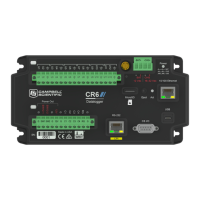2. Ensure the data logger is connected to the computer, select Yes to test communications,
then click Next to initiate the test. To troubleshoot an unsuccessful test, see Tips and
troubleshooting (p. 127).
3. With a successful connection, the Datalogger Clock window displays the time for both the
data logger and the computer.
l The Adjusted Server Date/Time displays the current reading of the clock for the
computer or server running your data logger support software. If the Datalogger
Date/Time and Adjusted Server Date/Time don't match, you can set the data logger
clock to the Adjusted Server Date/Time by clicking Set Datalogger Clock.
l Use the Time Zone Offset to specify a positive or negative offset to apply to the
computer time when setting the data logger clock. This offset will allow you to set
the clock for a data logger that needs to be set to a different time zone than the time
zone of the computer (or to accommodate for changes in daylight saving time).
4. Click Next.
5. The data logger ships with a default GettingStarted program. If the data logger does not
have a program, you can choose to send one by clicking Select and Send Program. Click
Next.
6. LoggerNet only - Use the following instructions or watch the Scheduled/Automatic Data
Collection video :
3. Setting up the CR6 42

